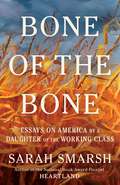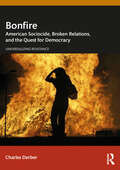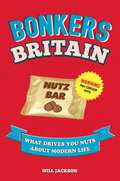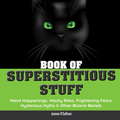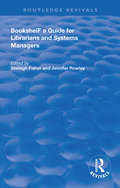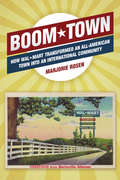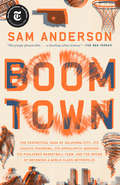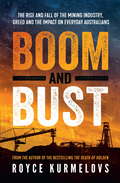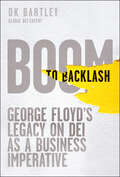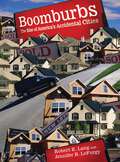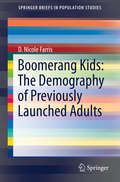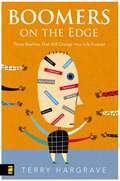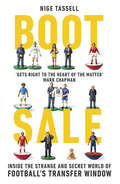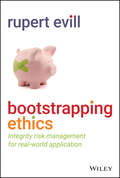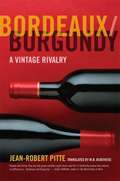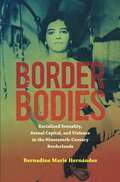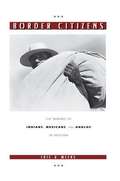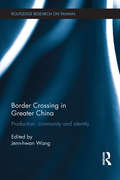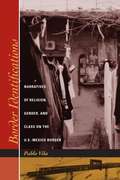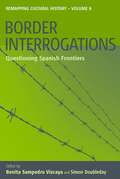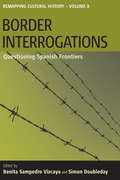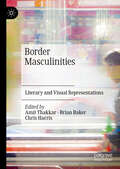- Table View
- List View
Bone of the Bone: Essays on America by a Daughter of the Working Class
by Sarah SmarshNow collected for the first time in one volume, the brilliant and provocative essays that established National Book Award finalist Sarah Smarsh as one of the most important commentators on socioeconomic class in America—featuring a previously unpublished essay and a new introduction.In Bone of the Bone, Sarah Smarsh brings her graceful storytelling and incisive critique to the challenges that define our times—class division, political fissures, gender inequality, environmental crisis, media bias, the rural-urban gulf. Smarsh, a journalist who grew up on a wheat farm in Kansas and was the first in her family to graduate from college, has long focused on cultural dissonance that many in her industry neglected until recently. Now, this thought-provoking collection of more than thirty of her highly relevant, previously published essays from the past decade (2013–2024)—ranging from personal narratives to news commentary—demonstrates a life and a career steeped in the issues that affect our collective future. Compiling Smarsh&’s reportage and more poetic reflections, Bone of the Bone is a singular work covering one of the most tumultuous decades in civic life. Timely, filled with perspective-shifting observations, and a pleasure to read, Sarah Smarsh&’s essays—on topics as varied as the socioeconomic significance of dentistry, laws criminalizing poverty, fallacies of the &“red vs. blue&” political framework, working as a Hooters Girl, and much more—are an important addition to any discussion on contemporary America.
Bonfire: American Sociocide, Broken Relations, and the Quest for Democracy (Universalizing Resistance)
by Charles DerberCharles Derber shows how the US is moving toward sociocide – the erosion of durable, positive social relations in the economy, family, politics, and civil society essential to sustaining society itself – while offering pragmatic solutions.Bonfire: American Sociocide, Broken Relations, and the Quest for Democracy examines how new technologies and financial strategies are part of broader economic, environment, cultural, and political shifts that create tipping points generating more competition, distrust, isolation, and violence. In doing so, Derber spells out the implications for democracy and social cohesion. Importantly, he explores options that could stop the spiral and reconstruct a sustainable and equitable community, civil society, and democracy via emerging movements against neoliberalism capitalism, climate change, war – and in favor of labor solidarity, human rights, and community.This book will be of interest to students, scholars and activists with an interest in political sociology, political economy, and social movements in the US.
Bonkers Britain: What Drives You Nuts about Modern Life
by Will JacksonHaving a good old moan about little everyday frustrations is a quintessential part of being British! This book collects the most mind-boggling and side-splitting examples of potty political correctness, ridiculous red tape and well-intentioned (but ultimately wacky) warnings from across bonkers Britain today.
Bonkers Britain: What Drives You Nuts about Modern Life
by Will JacksonHaving a good old moan about little everyday frustrations is a quintessential part of being British! This book collects the most mind-boggling and side-splitting examples of potty political correctness, ridiculous red tape and well-intentioned (but ultimately wacky) warnings from across bonkers Britain today.
Book of Superstitious Stuff
by Joanne O'SullivanFrom the curse of the lottery winners to the good feng shui of a local restaurant, this quirky, wacky, weird, and wonderful collection of superstitions uncovers the truth about some of our most familiar beliefs, as well as others that are much stranger. It turns out that everywhere in the world, people still put their trust in luck, magic, and mystery. By the end of this look at the bizarre world of illogic it's clear: superstition is alive and well...and really spellbinding!
Books, Bricks and Bytes: Libraries in the Twenty-first Century
by Stephen R. Graubard Paul LeClercLibraries are experiencing a technological revolution that goes well beyond anything that has existed since the invention of printing. Not surprisingly, the digital library, with all that it portends for the future of the book and the periodical, but also with all that it implies for the kinds of information that will be collected and disseminated, will necessarily preoccupy those responsible for libraries in the new century. Everything from copyright, access, and cost to the nature of the reading public itself is now up for re-examination.'Books, Bricks, and Bytes' brings together an extraordinary array of authors at the cutting edge of these concerns, not only within the United States, but experts drawn from Germany, France, Russia, the United Kingdom, Brazil, and India. James H. Billington discusses the Library of Congress in the information age; Ann S. Okerson outlines two models for securing scholarly information; Donald S. Lamm discusses the shaky partnership of publishers and librarians hi this new environment; Klaus-Dieter Lehmann provides a framework for maintaining the intellectual heritage of the past in a digitized future. Each contributor shows hi concrete detail and vivid illustration that the library as a world of holdings is increasingly valued as an incomparable place to access information. In his preface to the book, Stephen Graubard reminds us that whether or not one believes in the reality of the information revolution that is said to be overtaking the world, it is obvious that the libraries being built today do not resemble those marble sanctuaries constructed hi the Victorian age or in the early twentieth entury. This is a work that shows how libraries have been transformed from "refuges" from the external world, to places that reflect the social and intellectual values of specific societies. The idea that the library is a public trust and public resource is at the center of this unusually fine collection at the cutting edge of professional and public life.
Bookshelf: a Guide For Librarians and System Managers (Routledge Revivals)
by Jennifer Rowley Shelagh FisherFirst published in 1992, This guide, one of a series looking at library automation systems, will not only help prospective users in their systems choice, but will also give current a better appreciation of the potential of their own system.Written by users of the system and reflecting their experience, the guide examines BookshelF’s place in the automated libraries’ market, the company’s history, reliability and support services. All the hardware and software used in connection with BookshelF are described and the reader is taken through all the process involved in setting up the system, and introduced to the specific packages and application. This guide will also be interest to students of information management, information science and librarianship.
Boom Town: How Wal-Mart Transformed an All-American Town Into an International Community
by Marjorie RosenInvestigating the personal stories behind the headquarters of the Wal-Mart empire, this examination focuses on the growth of Bentonville, Arkansas--a microcosm of America's social, political, and cultural shift. Numerous personalities are interviewed, including a multimillionaire Palestinian refugee who arrived penniless and is now dedicated to building a synagogue, a Mexican mother of three who was fired after injuring herself on the job, a black executive hired to diversify Wal-Mart whose arrival coincided with a KKK rally, and a Hindu father concerned about interracial dating. In documenting these citizens' stories, this account reveals the challenges and issues facing those who compose this and other "boom towns"--where demographics, the economy, and immigration and migration patterns are continually in flux. In shedding light on these important and timely anecdotes of America's changing rural and suburban landscape, this exploration provides an entertaining and intimate chronicle of the different ethnicities, races, and religions as well as their ongoing struggles to adapt. Emerging as subtle sociology combined with drama and humanity, this overview illustrates the imperceptible and occasionally unpredictable movements that affect the nonmetropolitan environment of the United States.
Boom Town: The Fantastical Saga of Oklahoma City, its Chaotic Founding... its Purloined Basketball Team, and the Dream of Becoming a World-class Metropolis
by Sam AndersonAward-winning journalist Sam Anderson’s long-awaited debut is a brilliant, kaleidoscopic narrative of Oklahoma City--a great American story of civics, basketball, and destiny. <P><P>Oklahoma City was born from chaos. It was founded in a bizarre but momentous "Land Run" in 1889, when thousands of people lined up along the borders of Oklahoma Territory and rushed in at noon to stake their claims. <P><P>Since then, it has been a city torn between the wild energy that drives its outsized ambitions, and the forces of order that seek sustainable progress. <P><P>Nowhere was this dynamic better realized than in the drama of the Oklahoma City Thunder basketball team’s 2012-13 season, when the Thunder’s brilliant general manager, Sam Presti, ignited a firestorm by trading future superstar James Harden just days before the first game. Presti’s all-in gamble on “the Process”—the patient, methodical management style that dictated the trade as the team’s best hope for long-term greatness—kicked off a pivotal year in the city’s history, one that would include pitched battles over urban planning, a series of cataclysmic tornadoes, and the frenzied hope that an NBA championship might finally deliver the glory of which the city had always dreamed. <P><P>Boom Town announces the arrival of an exciting literary voice. Sam Anderson, former book critic for New York magazine and now a staff writer at the New York Times magazine, unfolds an idiosyncratic mix of American history, sports reporting, urban studies, gonzo memoir, and much more to tell the strange but compelling story of an American city whose unique mix of geography and history make it a fascinating microcosm of the democratic experiment. <P><P>Filled with characters ranging from NBA superstars Kevin Durant and Russell Westbrook; to Flaming Lips oddball frontman Wayne Coyne; to legendary Great Plains meteorologist Gary England; to Stanley Draper, Oklahoma City's would-be Robert Moses; to civil rights activist Clara Luper; to the citizens and public servants who survived the notorious 1995 bombing of the Alfred P. Murrah federal building, Boom Town offers a remarkable look at the urban tapestry woven from control and chaos, sports and civics.
Boom and Bust: The rise and fall of the mining industry, greed and the impact on everyday Australians
by Royce KurmelovsThis is a cautionary tale. About greed, irresponsibility and failing to learn from the past.Australia's mining boom is still talked about with a sense of awe. This once-in-a-lifetime event capped off 25 straight years of economic growth. Thanks to mining we sidestepped the worst of the Global Financial Crisis. To the rest of the world Australia was an economic miracle. And then the boom ended.Now Australia is grappling with what that means at a time of rising economic inequality and political upheaval. The end of the boom isn't about money - it's about people. Boom and Bust looks at what happens to those who came into vast wealth only to watch it dry up. To those who thought they had a good job for life, but didn't. The bust didn't just happen on stock-market screens - it was lived, and is still being lived right now, in dusty towns and cities all around the country.As he did in his bestselling book The Death of Holden, Royce Kurmelovs reveals the reality behind the headlines. Boom and Bust is a dirt-under-the-nails look at the winners, the losers and the impact of the boom that wasn't meant to end. This is a book all Australians should read.'Brilliant and powerful' Nick Xenophon on Royce Kurmelovs' THE DEATH OF HOLDEN
Boom to Backlash: George Floyd's Legacy on DEI as a Business Imperative
by DK BartleyHow the murder of George Floyd transformed the attitude towards and implementation of DEI across the world Boom to Backlash: George Floyd's Legacy on DEI as a Business Imperative examines the seismic shift in DEI initiatives following George Floyd's completely preventable death, exploring the initial surge of corporate commitments to DEI, the tangible progress and advancements made, and the subsequent backlash. Through data and case studies, as well as the unparalleled personal experiences of Black executive, global DEI expert, and author DK Bartley, this book illustrates how DEI has evolved from a fringe concept to a crucial element of business strategy, corporate success, and social progress. Some of the topics explored in this book include: The mischaracterization of DEI as “new” or “woke” by various platforms The real impact of DEI on a business's bottom line The future of DEI with respect to the current political climate and technology's role in implementation strategies Why George Floyd's murder was a catalyst for change By addressing these critical aspects of DEI within the context of recent historical events, Boom to Backlash engages with a growing audience of business and political leaders, social media influencers, HR professionals, and individuals who want to understand and implement effective DEI strategies in a post-2020 world.
Boomburbs
by Robert E. Lang Jennifer B. LefurgyA glance at a list of America's fastest growing "cities" reveals quite a surprise: most are really overgrown suburbs. Places such as Anaheim, California, Coral Springs, Florida, Naperville, Illinois, North Las Vegas, Nevada, and Plano, Texas, have swelled to big-city size with few people really noticing--including many of their ten million residents. These "boomburbs" are large, rapidly growing, incorporated communities of more than 100,000 residents that are not the biggest city in their region. Here, Robert E. Lang and Jennifer B. LeFurgy explain who lives in them, what they look like, how they are governed, and why their rise calls into question the definition of urban.Located in over twenty-five major metro areas throughout the United States, numerous boomburbs have doubled, tripled, even quadrupled in size between census reports. Some are now more populated than traditional big cities. The population of the biggest boomburb--Mesa, Arizona--recently surpassed that of Minneapolis and Miami.Typically large and sprawling, boomburbs are "accidental cities," but not because they lack planning. Many are made up of master-planned communities that have grown into one another. Few anticipated becoming big cities and unintentionally arrived at their status. Although boomburbs possess elements found in cities such as housing, retailing, offices, and entertainment, they lack large downtowns. But they can contain high-profile industries and entertainment venues: the Los Angeles Angels of Anaheim and Arizona Cardinals are among over a dozen major-league sports teams who play in the boomburbs.Urban in fact but not in feel, these drive-by cities of highways, office parks, and shopping malls are much more horizontally built and less pedestrian friendly than most older suburbs. And, contrary to common perceptions of suburbia, they are not rich and elitist. Poverty is often seen in boomburb communities of small single-family homes, neighborhoods that once represented the American dream. Boomburbs are a quintessential American landscape, embodying much of the nation's complexity, expansiveness, and ambiguity. This fascinating look at the often contradictory world of boomburbs examines why America's suburbs are thriving and how they are shaping the lives of millions of residents.
Boomburbs
by Robert E. Lang Jennifer B. LefurgyA glance at a list of America's fastest growing "cities" reveals quite a surprise: most are really overgrown suburbs. Places such as Anaheim, California, Coral Springs, Florida, Naperville, Illinois, North Las Vegas, Nevada, and Plano, Texas, have swelled to big-city size with few people really noticing-including many of their ten million residents. These "boomburbs" are large, rapidly growing, incorporated communities of more than 100,000 residents that are not the biggest city in their region. Here, Robert E. Lang and Jennifer B. LeFurgy explain who lives in them, what they look like, how they are governed, and why their rise calls into question the definition of urban.Located in over twenty-five major metro areas throughout the United States, numerous boomburbs have doubled, tripled, even quadrupled in size between census reports. Some are now more populated than traditional big cities. The population of the biggest boomburb-Mesa, Arizona-recently surpassed that of Minneapolis and Miami.Typically large and sprawling, boomburbs are "accidental cities," but not because they lack planning. Many are made up of master-planned communities that have grown into one another. Few anticipated becoming big cities and unintentionally arrived at their status. Although boomburbs possess elements found in cities such as housing, retailing, offices, and entertainment, they lack large downtowns. But they can contain high-profile industries and entertainment venues: the Los Angeles Angels of Anaheim and Arizona Cardinals are among over a dozen major-league sports teams who play in the boomburbs.Urban in fact but not in feel, these drive-by cities of highways, office parks, and shopping malls are much more horizontally built and less pedestrian friendly than most older suburbs. And, contrary to common perceptions of suburbia, they are not rich and elitist. Poverty is often seen in boomburb communities of small single-family homes, neighborhoods that once represented the American dream.Boomburbs are a quintessential American landscape, embodying much of the nation's complexity, expansiveness, and ambiguity. This fascinating look at the often contradictory world of boomburbs examines why America's suburbs are thriving and how they are shaping the lives of millions of residents.
Boomerang Kids: The Demography of Previously Launched Adults (SpringerBriefs in Population Studies)
by D. Nicole FarrisCombining statistical analyses and personal interviews, this book examines the phenomenon of adult children in the United States who have returned to living with their parents in the family home. It uses both data and narrative to fully detail how such co-residency has shaped this ever-increasing demographic group, who are often referred to as "previously launched adults" or " boomerang children. " The author first presents quantitative research using data obtained from the National Survey of Families and Households. Readers will discover the various demographic, household, and economic variables that might lead an individual to move back in with his or her family. This statistical analysis is complemented by 50 qualitative interviews that offer a more in-depth look at the trend from the point of view of those who have experienced it. These interviews of both adult children and their parents cover such areas as personal background, the effects of returning to the parental home, and self-esteem issues. In addition, the book offers cross-country comparisons by looking at the prevalence of this phenomenon in China and Greece. It discusses the different cultural contexts in which adult child and parent co-residence is not seen as particularly deviant, as it is in America, as well as identifies some of the demographic and economic factors that would cause those in different countries to continue to live with their parents. This book furthers research into the sociological study of the family. The quantitative analyses describe the large scale trends and their implications, the interviews provide an important personal context, while the cross-country comparisons offer additional perspectives. Overall, readers will gain a complete picture of this unprecedented demographic shift in the United States, including important policy implications and the plight of young adults coming of age in the 21st century.
Boomers on the Edge: Three Realities That Will Change Your Life Forever
by Terry HargraveThe baby boomer generation is under siege. Their aging parents need care. Their adult children are moving back home. And they are going back to work because retirement savings are running out. This book helps boomers negotiate the difficult changes, and see how God figures into these changes and how their faith can help them through.
Boot Sale: Inside the Strange and Secret World of Football's Transfer Window
by Nige TassellDiscover the hectic behind-the-scenes drama of transfer deadlines through the players, managers, chairmen, agents, scouts, analysts, fans, journalists, broadcasters and bookmakers.For football fans who hungrily feed on gossip and rumour, Christmas comes twice a year - once in August and again in January. These are the months when the transfer window dominates thoughts, when the prospect of a new signing or two reinvigorates the hopes and dreams of the hopelessly devoted.Nige Tassell goes behind the scenes to observe the workings of the transfer window and to examine why it continues to hold such fascination for a nation of football lovers. He speaks to players, managers, chairmen, agents, scouts, analysts, fans, journalists, broadcasters and even bookmakers to hear how they survive - and possibly prosper from - these red-letter months in the football calendar.Nobody writes about football like Nige Tassell: poignant, funny, nostalgic and reminds us why we love the game.
Bootstrapping Ethics: Integrity Risk Management for Real-World Application
by Rupert EvillPractical, cost-effective tools for personal and organizational risk mitigation In Risk Management: Tools, Tips, and Techniques to Help Your Organization Achieve Its Strategic Goals, accomplished fraud investigator and risk advisor Rupert Evill delivers a smart, simple, and hands-on guide to managing risk and ethics in your organization. You&’ll learn to protect yourself, your organization, and your stakeholders from regulatory and other risks with frontline-tested strategies and frameworks designed to achieve both quick wins and long-term risk mitigation. In the book, the author shows you how to create tangible economic returns by reducing organizational exposure to common—and not-so-common—risks by promoting the right values, managing conflict, prioritizing the communities you serve, and preventing discrimination and harassment against your employees. You&’ll also: Learn to manage external stakeholders and their expectations Keep your risk mitigation strategies cost-effective and straightforward so you can scale them throughout your organization Get on top of your diversity, equity, and inclusion efforts and make sure they&’re getting resultsA can&’t-miss resource for purpose-driven changemakers looking to maximize their impact at the organizations they serve and in the world, Risk Management is also the tactical and practical antidote to the seemingly endless stream of new regulations and oversight facing many modern firms.
Bordeaux / Burgundy: A Vintage Rivalry
by Jean-Robert Pitte Malcolm DebevoiseSeeking to penetrate the mysteries of two great wine regions--"two opposite civilizations, two distinct ways of feeling"--Jean-Robert Pitte embarks upon an evocative and fascinating exploration of the land, people, and wines of Bordeaux and Burgundy. His account is a rich tapestry of terroir, history, culture, and economics from Roman to modern times. The unique qualities of the wines of each region, Pitte believes, cannot be entirely explained by the differences in their physical environments: they have social origins as well. Beginning with an entertaining look at the remarkable variety of insults exchanged by partisans of the two regions, Pitte delves into the key role played by medieval monks, dukes, and peasant vignerons in building their respective reputations and in creating the rivalry between bourgeois Bordeaux and earthy Burgundy that we know today. His sparkling, fair-minded narrative, engaging the senses and the mind alike, conveys a deep appreciation of two incomparable wine growing cultures, united despite their differences by a common ambition to produce the best wines in the world.
Border Bodies: Racialized Sexuality, Sexual Capital, and Violence in the Nineteenth-century Borderlands
by Bernadine Marie HernandezIn this study of sex, gender, sexual violence, and power along the border, Bernadine Marie Hernandez brings to light under-heard stories of women who lived in a critical era of American history. Elaborating on the concept of sexual capital, she uses little-known newspapers and periodicals, letters, testimonios, court cases, short stories, and photographs to reveal how sex, violence, and capital conspired to govern not only women's bodies but their role in the changing American Southwest. Hernandez focuses on a time when the borderlands saw a rapid influx of white settlers who encountered elite landholding Californios, Hispanos, and Tejanos. Sex was inseparable from power in the borderlands, and women were integral to the stabilization of that power. In drawing these stories from the archive, Hernandez illuminates contemporary ideas of sexuality through the lens of the borderland's history of expansionist, violent, and gendered conquest. By extension, Hernandez argues that Mexicana, Nuevomexicana, Californiana, and Tejana women were key actors in the formation of the western United States, even as they are too often erased from the region's story.
Border Citizens
by Eric V. MeeksBorders cut through not just places but also relationships, politics, economics, and cultures. Eric V. Meeks examines how ethno-racial categories and identities such as Indian, Mexican, and Anglo crystallized in Arizona's borderlands between 1880 and 1980. South-central Arizona is home to many ethnic groups, including Mexican Americans, Mexican immigrants, and semi-Hispanicized indigenous groups such as Yaquis and Tohono O'odham. Kinship and cultural ties between these diverse groups were altered and ethnic boundaries were deepened by the influx of Euro-Americans, the development of an industrial economy, and incorporation in the U. S. nation-state. Old ethnic and interethnic ties changed and became more difficult to sustain when Euro-Americans arrived in the region and imposed ideologies and government policies that constructed starker racial boundaries. As Arizona began to take its place in the national economy of the United States, primarily through mining and industrial agriculture, ethnic Mexican and Native American communities struggled to define their own identities. They sometimes stressed their status as the region's original inhabitants, sometimes as workers, sometimes as U. S. citizens, and sometimes as members of their own separate nations. In the process, they often challenged the racial order imposed on them by the dominant class. Appealing to broad audiences, this book links the construction of racial categories and ethnic identities to the larger process of nation-state building along the U. S. -Mexico border, and illustrates how racial differences can both fuse cultures together and drive them apart.
Border Crossing in Greater China: Production, Community and Identity (Routledge Research on Taiwan Series)
by Jenn-Hwan WangChina’s transformation from a poor and underdeveloped country into a global market power has profoundly altered its socioeconomic power relations with the other countries in the Greater China region, namely, Taiwan and Hong Kong. Indeed, this economic shift has resulted in the massive flow of capital and people from Taiwan as well as Hong Kong to China, to seek business opportunities and new lifestyles. These flows have in turn completely transformed longstanding borderlines in the region. This book examines the transformation of Taiwan and Hong Kong’s socioeconomic relationships with China as their economies have become more deeply integrated into Greater China. Across three key sections, it explores the impact of increasing social interaction and the shrinking of existing borderlines to ask whether these changes will bring about a convergence of identity among the people involved. "Production" examines how investments from Taiwan and Hong Kong to China have transformed production networks; "Community" explores the impact of cross-boundary mobility and the integration of migrants into Chinese communities; and finally, "Identity" engages with what is one of the most important issues in contemporary Taiwanese society. Border Crossing in Greater China contributes not only to theoretical debates on border crossing issues, but also provides valuable insights on the practical concerns regarding social and political integration and tensions in the region. As such, it will be of great interest to students and scholars of Taiwan studies, Chinese studies, Chinese society and Chinese economics.
Border Identifications: Narratives of Religion, Gender, and Class on the U.S.-Mexico Border
by Pablo VilaIn this book, Vila continues the exploration of identities he began in Crossing Borders, Reinforcing Borders by looking at how religion, gender, and class also affect people's identifications of self and "others" among Mexican nationals, Mexican immigrants, Mexican Americans, Anglos, and African Americans in the Cuidad Juárez-El Paso area. Among the many fascinating issues he raises are how the perception that "all Mexicans are Catholic" affects Mexican Protestants and Pentecostals; how the discourse about proper gender roles may feed the violence against women that has made Juárez the "women's murder capital of the world"; and why class consciousness is paradoxically absent in a region with great disparities of wealth. His research underscores the complexity of the process of social identification and confirms that the idealized notion of "hybridity" is only partially adequate to define people's identity on the U.S.-Mexico border.
Border Interrogations
by Benita Samperdro VizcayaUnder the current cartographies of globalism, where frontiers mutate, vacillate, and mark the contiguity of discourse, questioning the Spanish border seems a particularly urgent task. The volume engages a wide spectrum of ambivalent regions--subjects that currently are, or have been seen in the past, as spaces of negotiation and contestation. However, they converge in their perception of the "Spanish" nation-space as a historical and ideological construct that is perpetually going through transformations and reformations. This volume advocates the position that intellectual responsibility must lead us to engage openly in the issues underlying current social and political tensions.
Border Interrogations: Questioning Spanish Frontiers (Remapping Cultural History #8)
by Benita Samperdro Vizcaya Simon DoubledayUnder the current cartographies of globalism, where frontiers mutate, vacillate, and mark the contiguity of discourse, questioning the Spanish border seems a particularly urgent task. The volume engages a wide spectrum of ambivalent regions--subjects that currently are, or have been seen in the past, as spaces of negotiation and contestation. However, they converge in their perception of the "Spanish" nation-space as a historical and ideological construct that is perpetually going through transformations and reformations. This volume advocates the position that intellectual responsibility must lead us to engage openly in the issues underlying current social and political tensions.
Border Masculinities: Literary and Visual Representations
by Chris Harris Amit Thakkar Brian BakerThis volume collates and examines literary and screened representations of what the editors term ‘border masculinities’. It seeks to understand masculine subjectivities, through fiction and screen, within a complex global arena of relationships and fluid movements across multiple boundaries within that arena. It also concerns paradigmatic borders related to class, gender and ethnicities, as well as other theoretical parameters which cut across porous spatial boundaries. This collection contains a range of theoretically informed responses to varying cultural representations of such masculinities in Europe, the Americas, the Caribbean, Australasia and Asia. Thematic and conceptual connections between them are discussed in the introductory chapter and such links are also made between chapters.
